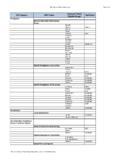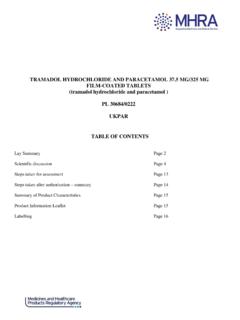Transcription of 1. PRODUCT NAME 2. QUALITATIVE AND …
1 1 New Zealand Data Sheet Tramal Capsules Tramal Solution for Injection Tramal SR Tablets 1. PRODUCT NAME Tramal ( tramadol hydrochloride ) immediate release capsules 50 mg Tramal ( tramadol hydrochloride ) solution for injection 50 mg/mL, 100 mg/2mL Tramal SR tablets ( tramadol hydrochloride ) sustained release tablets) 50 mg, 100 mg, 150 mg, 200 mg 2. QUALITATIVE AND QUANTITATIVE COMPOSITION Tramal 50 mg capsules are yellow-yellow capsules containing: 50 mg tramadol hydrochloride . Tramal 50 mg and 100 mg injections contain: tramadol hydrochloride 50 mg/mL. Tramal SR sustained release tablets contain: tramadol hydrochloride in the following dose strengths: 50, 100, 150 and 200 mg. For full list of excipients, see section List of excipients.
2 Tramal capsules, Tramal solution for injection, and Tramal SR tablets contain tramadol hydrochloride which is ( +) - cis-2-(dimethylaminomethyl)-1-(3-methoxy phenyl)-cyclohexanol hydrochloride . tramadol hydrochloride is an odourless, white to off-white crystalline powder that is readily soluble in both water and ethanol and has a pKa of The water/n-octanol partition coefficient is at pH 7. It belongs to the synthetic analgesics class and has opioid-like activity, with the formula: C16 H25 NO2. HCl. MW = The structural formula of tramadol hydrochloride is:- The CAS Registry Number is 36282-47-0. 3. PHARMACEUTICAL FORM Tramal capsules are oblong, yellow/yellow, shiny hard gelatine capsules size 4. Tramal solution for injection is clear, colourless solution.
3 2 Tramal SR 50mg sustained release tablets are pale yellow coloured, round, biconvex, film-coated tablets, engraved with "T0" on one side and Grunenthal logo on the other side. Tramal SR 100 mg sustained release tablets are supplied as white, round, biconvex, film-coated tablets, engraved with"T1" on one side and the Grunenthal logo on the other side. Tramal SR 150 mg sustained release tablets are supplied as pale orange-coloured, round, bi-convex, film-coated tablets, engraved with "T2" on one side and the Grunenthal logo on the other side. Tramal SR 200 mg sustained release tablets are supplied as slightly brownish orange-coloured, round, bi-convex, film-coated tablets, engraved with "T3" on one side and the Grunenthal logo on the other side 4.
4 CLINICAL PARTICULARS Therapeutic indications Relief of moderate to severe pain. Dose and method of administration Dose The dose of tramadol should be titrated to the severity of the pain and the clinical response of the individual patient. tramadol is approved for use in adults, adolescents and children over the age of 12 years. The recommended dosage of Tramal capsules, Tramal solution for injection, and Tramal SR tablets respectively are as follows: Tramal capsules Oral administration - for the treatment of moderate pain Tramal 50 100 mg administered two or three times daily may be sufficient. Tramal 50 mg may be adequate as the initial dose for moderate pain. For moderate to severe pain, 50 100 mg as needed for relief, every four to six hours may be administered.
5 Tramal 100mg is usually more effective as the initial dose for more severe pain. The maximum daily dose should not exceed 400mg per day. Tramal solution for injection Parenteral administration - Tramal injection may be administered by intravenous injection by intravenous or intramuscular injection. Few data are available on the administration of Tramal by repeated intramuscular injection. Intravenous injections should be given slowly over 2-3 minutes. For postoperative pain, an initial bolus of 100 mg should be administered. Subsequent doses of 50 mg or 100mg every four to six hours may be given, up to a total daily dose of 600 mg. 3 For less severe pain, 50 mg or 100 mg every four to six hours to a maximum of 400 mg per day. PHARMACEUTICAL PRECAUTIONS Tramal solution for injection is incompatible with injection solutions containing diclofenac, indomethacin, phenylbutazone, diazepam, flunitrazepam, glyceryl trinitrate or midazolam.
6 Tramal solution for injection is compatible with the following intravenous fluids: sodium chloride, 5% glucose, sodium bicarbonate, Ringer s solution, Ringer s lactate solution, Dextran 40 (10%) or polygeline Tramal SR tablets Oral administration - the recommended dose of Tramal SR in adults and adolescents over the age of 12 years is 100 mg to 200 mg twice daily, preferably morning and evening. For initial titration therapy, a lower starting dose may be appropriate for some patients. The tablets are to be taken whole, not divided or chewed, with sufficient liquid, irrespective of food intake. The maximum daily dose should not exceed 400 mg per day. Paediatric use - Tramal solution for injection are approved for use in children 12 years old and over.
7 Analgesic dosage of Tramal solution for injection must be individualised by the physician according to the severity of pain as well as on the basis of patient's age and weight. Renal insufficiency - in patients with renal insufficiency the elimination of tramadol is delayed. In these patients prolongation of the dosage intervals should be carefully considered according to the patient s requirements. In cases of severe renal insufficiency Tramal prolonged-release tablets are not recommended. Since only 7% of an administered dose is removed by haemodialysis, dialysis patients can receive their regular dose on the day of dialysis. Hepatic insufficiency - Tramal SR should not be used in patients with severe hepatic insufficiency. In these patients, the immediate release (IR) form of oral tramadol (capsule) may be administered if appropriate.
8 In hepatic impairment, the initial oral dose of tramadol is 50 mg of the immediate release formulation. Depending on the severity of the impairment and individual clinical response, the recommended dosage interval (4-6 hours) may require to be extended, and/or the dose level titrated as required. Method of administration For method of administration see section Dose and method of administration. Contraindications tramadol is contraindicated in: individuals with known hypersensitivity to tramadol or any excipients listed in section acute intoxication with alcohol, hypnotics, analgesics, opioids or psychotropic drugs all children younger than 12 years of age (see section Special warnings and precautions for use) postoperative management of children younger than 18 years of age following tonsillectomy and/or adenoidectomy (see section Special warnings and precautions for use) 4 patients who are taking MAO inhibitors or who have taken them within the last 14 days known hypersensitivity to opioids patients with uncontrolled epilepsy or epilepsy not adequately controlled by treatment.
9 tramadol must not be used for narcotic withdrawal treatment. Special warnings and precautions for use Galactose intolerance Tramal SR tablets contain mg lactose monohydrate per tablet. Patients with rare hereditary problems of galactose intolerance, the Lapp lactase deficiency or glucose-galactose malabsorption should consult a physician before use. Acute abdominal conditions The administration of tramadol may complicate the clinical assessment of patients with acute abdominal conditions. Respiratory depression and sedation tramadol should be administered cautiously in patients at risk of respiratory depression. Cases of intra-operative respiratory depression, usually with large intravenous doses of tramadol and with concurrent administration of respiratory depressants, have been reported.
10 Profound sedation, respiratory depression, coma, and death may result from the concomitant use of tramadol with benzodiazepines or other CNS depressants ( , non-benzodiazepine, sedatives/hypnotics, anxiolytics, tranquilizers, muscle relaxants, general anaesthetics, medicines with antihistamine-sedating actions such as antipsychotics, other opioids and alcohol). Because of these risks, reserve concomitant prescribing of these drugs for use in patients for whom alternative treatment options are inadequate. Observational studies have demonstrated that concomitant use of opioid analgesics and benzodiazepines increases the risk of medicine-related mortality compared to use of opioid analgesics alone. Because of similar pharmacological properties, it is reasonable to expect similar risk with the concomitant use of other CNS depressant drugs with opioid analgesics (see Section Interactions with other medicines and other forms of interaction).















